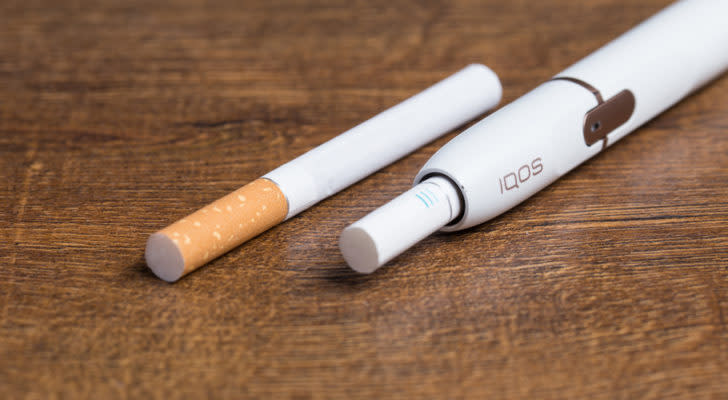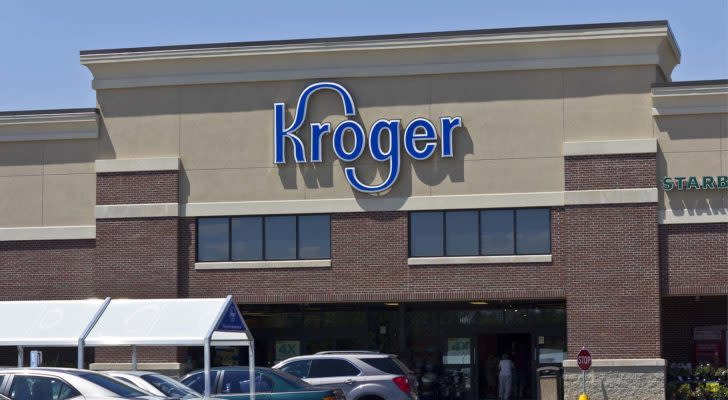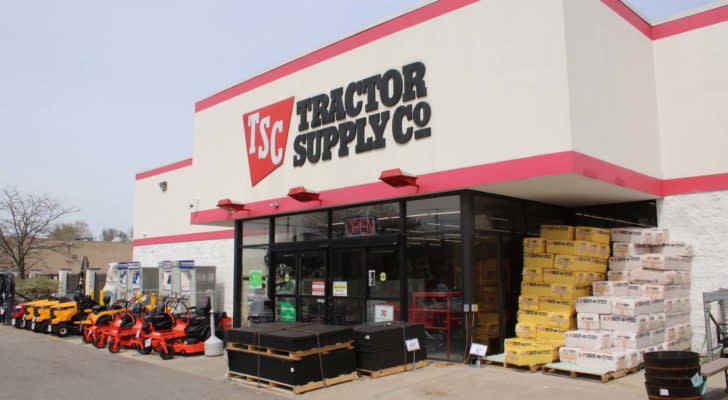7 No-Frills Dividend Stocks for Your Must-Own List
Dividends are a signal to investors of a profitable business. Typically the most successful companies pay investors to own their stock. They have been thoroughly tested by the market and have not only survived but thrived. No-frills dividend stocks also tend to make the best investments.
The asset managers at Hartford Funds looked at the performance of the S&P 500 going all the way back to 1930. They found there was never a decade when dividend stocks on the index produced a negative return. Non-payers couldn’t say the same thing.
A $10,000 investment in the benchmark index in 1960 that reinvested dividends would have turned into $4 million today compared to just $641,000 based on the index’s price alone. Buying solid, dividend growth stocks is your best bet for generating tremendous wealth. These seven companies are among the best you can buy today.
InvestorPlace - Stock Market News, Stock Advice & Trading Tips
Realty Income (O)

Source: Shutterstock
One of the best dividend stocks out there is Realty Income (NYSE:O). The real estate investment trust (REIT) is a triple net lease REIT that typically invests in single-tenant commercial real estate. That means most of its properties are occupied by just one tenant (it’s not own shopping malls with dozens or hundreds of businesses in them) and the tenants are responsible for the rent, insurance, maintenance and taxes. It makes the REIT a low-cost operator.
Realty Income only has high-quality, top-tier tenants, too. Companies like Dollar General (NYSE:DG), Walgreens (NASDAQ:WBA) and Walmart (NYSE:WMT) are representative of its tenant list. What sets the REIT apart from most of its peers is it pays its dividend monthly. It essentially created the niche and bills itself as” The Monthly Dividend Company.”
The payout has grown by over 5% annually for the past 10 years while its adjusted funds from operations (AFFO) (a metric similar to free cash flow (FCF) for REITs) has grown at nearly 19% annually. With a healthy AFFO payout ratio of around 80%, expect to keep getting your growing dividend payment every month for years to come. Realty Income recently made its 644th consecutive monthly dividend payment in the company’s 55-year history.
Coca-Cola (KO)

Source: BORIMAT PRAOKAEW / Shutterstock.com
Coca-Cola (NYSE:KO) is the most valuable and strongest non-alcoholic beverage company in the world. Brand Finance calculates Coke’s brand value at $33.5 billion because of its iconic logo and the consumer loyalty attached to it worldwide. Of course, the company is much more than just a soda business today. It also owns juices, tea, water, energy drinks and more all with significant market share in their respective fields. They also possess greater growth potential than soda, too.
Coke first began paying dividends in the 1920s and embarked on a campaign of continuous annual increases in the payout beginning in 1967. It has a 57-year history of hiking its dividend, which currently yields 3.3% annually. The beverage company has grown its dividend at a compounded annual growth rate (CAGR) of 4.8% for the past decade. Coke just announced a new increase, too, of 5.4%. The annual dividend will now be $1.94 per share.
What makes Coca-Cola especially attractive is it is a cash-generating machine. It ended 2023 with FCF at just under $10 billion. And because it produces FCF far above the dividends its pays, there is a long runway for future payments and growth for investors.
Johnson & Johnson (JNJ)

Source: Sundry Photography / Shutterstock.com
Pharmaceutical giant Johnson & Johnson (NYSE:JNJ) is dividend royalty with a 62 consecutive-year track record of dividend increases. Its 10-year dividend CAGR of 5.6% allowed it to grow the payout from $2.59 per share back in 2013 to $4.70 per share today. With a FCF payout ratio of 64% the dividend is safe and secure.
FCF is an important metric to know for a company. It is the money left over after a business pays its bills that they can use to invest in the company, buy back stock and yes, pay dividends. It is a better yardstick to measure the dividend against than earnings when calculating a payout ratio. And Johnson & Johnson excels.
The pharmaceutical stock is fairly recession-resistant because people need to take their medications regardless of economic conditions. And having spun off its consumer products company into the standalone company Kenvue (NYSE:KVUE) last year, Johnson & Johnson is now more narrowly focused on its core billion-dollar drug portfolio. It’s a no-nonsense dividend stock that is revered for its consistency and safety.
Philip Morris International (PM)

Source: vfhnb12 / Shutterstock.com
Global tobacco company Philip Morris International (NYSE:PM) is a standout dividend stock even as its free cash flow generation has slowly deteriorated over time. That’s because the cigarette maker still produces around $8 billion annually of FCF. It suffered a temporary reduction last year even as it maintained its dividend growth policies, which caused its payout ratio to exceed 100%. Philip Morris should resume its growth trajectory going forward.
Although smoking remains on a secular decline in the U.S., it is still a robust business elsewhere around the world, especially in Asia. Because Philip Morris has the global rights to the top-selling Marlboro brand everywhere but in the U.S., the tobacco stock remains well-positions to capitalize on continuing demand.
Yet it was Philip Morris that initiated the smoke-free future mantra that many other tobacco stocks have since adopted. It sells the leading IQOS electronic cigarette and acquired tobacco-free nicotine pouch maker Swedish Match in 2022. Reduced-risk products are the primary focus of the company even as cigarettes still generate the lion’s share of revenue. And the addictive nature of nicotine has its customers returning for more. It is why Philip Morris International remains a highly profitable company and why its dividend will keep on growing.
American Express (AXP)

Source: Shutterstock
Financial services leader American Express (NYSE:AXP) continues its run to new 52-week highs. Net interest income (NII) is benefiting from the high-interest rate environment and will likely keep doing so for the foreseeable future. Federal Reserve chairman Jay Powell will be testifying before Congress this week and explain why the agency is in no rush to cut interest rates just yet.
American Express typically pursues higher net worth customers than other credit card issuers but lately has been targeting a younger demographic. That is working out better than many people expected as the card company reported stronger-than-expected credit quality, lower-than-expected net charge-offs and rising loan growth. It is part of the reason Warren Buffett loves the stock. He said it is a one of a kind business and “You can’t create another American Express.”
Over the past decade, AmEx has grown its dividend at nearly 10% annually while expanding FCF at a near-9% rate. With an FCF payout of only 10%, there is little danger of dividend growth not being sustainable.
Kroger (KR)

Source: Jonathan Weiss / Shutterstock.com
Kroger (NYSE:KR) is the largest pure-play grocery store chain in the country with over 1,200 stores in 12 states. That leaves plenty of room for this solid company to continue growing over time along with its dividend.
The supermarket retailer has a 10-year CAGR of 5.5% a year. Over the past five years, however, Kroger nearly tripled its payout’s rate of growth to 14%. FCF has fluctuated over time but it routinely exceeds dividends paid making the payout secure.
Kroger is attempting to acquire rival grocer Albertson’s (NYSE:ACI) but is meeting resistance from the Federal Trade Commission (FTC). The regulatory agency is much more adversarial to large mergers during the Biden administration. It blocked JetBlue‘s (NASDAQ:JBLU) acquisition of Spirit Airlines (NASDAQ:SAVE), Illumina‘s (NASDAQ:ILMN) bid to sell Grail, blocked numerous hospital mergers, and issued tough new guidelines for such deals.
The FTC opposes Kroger taking over Albertson’s because it believes it will weaken unions. The agency’s record when challenged in court is spotty because it often overreaches. Industry trade groups say the Kroger case could be another example but could tamp down other M&A activity if successful.
Kroger is a strong, profitable grocer that will survive the government’s challenge regardless of how the case works out. And it will reward shareholders with ongoing dividend payments.
Tractor Supply (TSCO)

Source: Shutterstock
Rural lifestyle retailer Tractor Supply (NASDAQ:TSCO) is the last no-frills dividend stock investors should buy. It operates over 2,200 stores in 49 states but has been on an expansion binge. It took the retailer 72 years to open its first 1,000 stores but was able to open the next 1,000 within just 10 years. Tractor Supply now believes there is room for 3,000 Tractor Supply stores in the country that can support its $180 billion total addressable market.
Last year the retailer achieved record sales of $14.6 billion including for the first time over $1 billion in e-commerce sales. It is one of Tractor Supply’s fastest-growing opportunities. Profits were also at a record of $10.09 per share. And for the second consecutive year, the company returned over $1 billion to shareholders through the combination of rising dividend payments and stock buybacks.
Tractor Supply’s 10-year dividend CAGR is an astounding 22% coupled with an equally impressive FCF CAGR of 17.5%. Both of those accelerated more recently with five-year CAGRs of 26% and 25%, respectively. It shows you don’t have to be a flashy tech stock to generate healthy returns.
The country-living retailer offers investors a total return that has quadrupled in value over the past decade, handily outpacing the 200% return by the S&P 500. This is a company on a meteoric growth trajectory yet it stays out of the limelight. That’s unlike some other retailers who grab headlines with far less inspiring results.
On the date of publication, Rich Duprey held a LONG position in O, KO, WBA and JNJ stock. The opinions expressed in this article are those of the writer, subject to the InvestorPlace.com Publishing Guidelines.
Rich Duprey has written about stocks and investing for the past 20 years. His articles have appeared on Nasdaq.com, The Motley Fool, and Yahoo! Finance, and he has been referenced by U.S. and international publications, including MarketWatch, Financial Times, Forbes, Fast Company, USA Today, Milwaukee Journal Sentinel, Cheddar News, The Boston Globe, L’Express, and numerous other news outlets.
More From InvestorPlace
The #1 AI Investment Might Be This Company You’ve Never Heard Of
Musk’s “Project Omega” May Be Set to Mint New Millionaires. Here’s How to Get In.
It doesn’t matter if you have $500 or $5 million. Do this now.
The post 7 No-Frills Dividend Stocks for Your Must-Own List appeared first on InvestorPlace.
